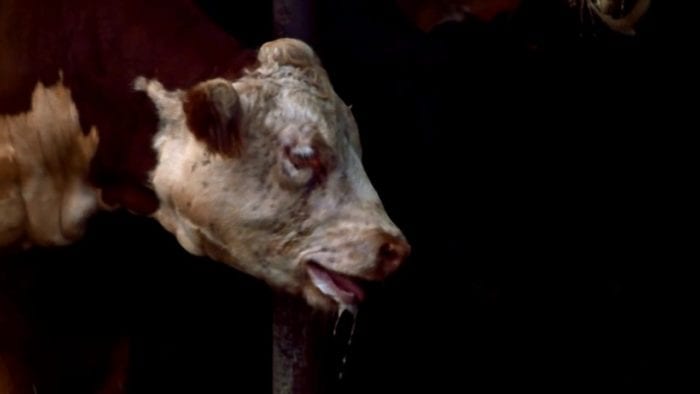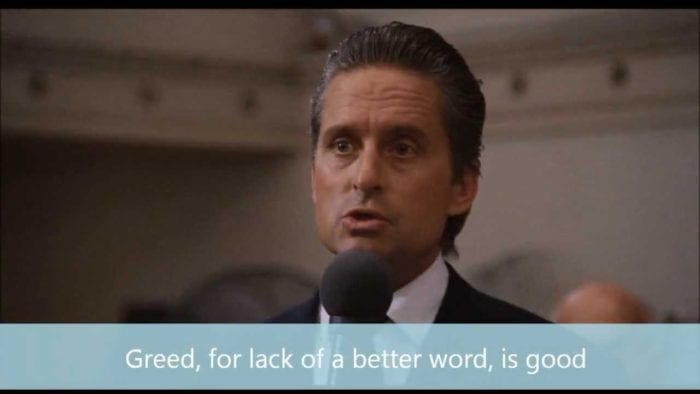In a previous article, I wrote about the ways in which certain formal elements of The Texas Chain Saw Massacre* create a destabilizing effect for the audience. While that analysis was far from exhaustive, it at least touched on some salient examples of The Texas Chain Saw Massacre’s most effective formal elements. Here, I would like to switch the focus from the film’s formal elements to its thematic elements. As I noted in my previous article, The Texas Chain Saw Massacre is a film in which the formal and thematic elements complement each other to a degree that few films can manage. One way, perhaps the best way, to describe the cumulative effect of these elements is “unsettling.”
Another word that comes to mind is “unease”; The Texas Chain Saw Massacre is certainly a film that causes a good deal of unease. However, as I began to think of ways other than “unsettling” or “unnerving” to describe something that causes a sense of unease, the word that came to mind was “dis-easing,” which of course isn’t actually a word, though it seems like it should be the appropriate verb form of the noun “disease.” It is interesting that there is no verb form of “unease” that includes the root word “ease.” To find a verb that fits the noun, one must turn to “discomfort” (which, unlike “unease,” can be used as both a noun and a verb). So, while I would certainly consider The Texas Chain Saw Massacre discomforting, it was the nonexistent “dis-ease” that sprang immediately to mind and which seemed somehow more appropriate.
A Picture of Poor Health
I like the idea of describing The Texas Chain Saw Massacre with this verb form of “disease.” It feels quite appropriate for a film that, though it does not deal with disease in a literal sense, is nonetheless very much concerned with disease in several forms and on different scales. One of the early, scathing reviews of the film—of which there were many—described it as “a vile little piece of sick crap.” I would concede that most of those words do accurately describe the film; it is vile, and I suppose “little” could be considered accurate since it’s only 80+ minutes long (“nasty, brutish, and short” would be just as apt). Most importantly though, it is sick, or in other words, diseased; more accurately, though, it is very much a depiction of disease.

The Texas Chain Saw Massacre is relentless in its extreme depictions of disease at the individual-psychological level as well as at the social-psychosocial level. These depictions include both the diseased individual mind, as represented by each member of the cannibal family, as well as the smaller-level social disease (and here we may regard disease and dysfunction as more or less synonymous terms) represented by the family as a whole.
After all, what are the family of cannibals but a depiction of family as an organism very much in the throes of disease? Finally, we can consider the film as a depiction of higher-level disease-dysfunction at the societal level i.e., a society, a nation, even a world suffering the ills of disease writ large. In the case of The Texas Chain Saw Massacre, broadening the scope to encompass disease-dysfunction at the national or even global level makes sense, as there is ample evidence from both within and without the text to support it. Within the text, we have, for example, the fact that what brings the young people to their doom is running out of gas, finding the service station is all out, and going in search of it elsewhere, all of which reflects the very real energy crisis going on at the time.
More generally, the very opening of the film, with its abstract imagery of sunspots and radio reports of depravity and disaster from all over the world, portends something wrong on a global, even cosmic, scale. Beyond these elements, the entire film seems, if not commentary on, at the very least colored by national and global events such as Watergate and the Vietnam War (and, if there were any doubt, Tobe Hooper himself confirmed numerous times the influence, even if indirect, of national and world affairs on the film).
Importantly, for the purposes of this discussion, the “disease” in question is distinctly a disease of the mind. Thus, it can be argued that The Texas Chain Saw Massacre presents us with a graphic portrayal of a world that has quite simply lost its mind, understanding “mind” here in the sense of the human faculties of reason and impulse control, as well as in that sense of “mind” that lies at the junction of science and religion, secular and sacred—“mind” as that intangible essence which, in other contexts, might be referred to as the soul.
This seems reasonable as even the most scientific secular would acknowledge that surely whatever we mean when we refer to a “moral compass” can have its basis only in the workings of the human mind. Therefore, a world that has lost its mind would be one that is not only deeply irrational and chaotic but quite immoral as well. Although, an argument could be made that perhaps it would be more amoral than immoral. However, even if this were the case, it would nevertheless mean a world which is indifferent, even cruelly so, and thus devoid of such intrinsically human qualities as sympathy and empathy.
Deep In the Black Heart of Texas
This conception of The Texas Chain Saw Massacre as a portrait of a world sick in the mind (or the soul) aligns well with its reputation as a deeply nihilistic film. It is, indeed, a film that stands out in this regard even in a genre known for nihilism. At the time, it was certainly more pessimistic than most horror films, certainly more than most that had preceded it and even more so than other, similar horror films of the era. Even now, its intense cynicism is not diminished and its role in inspiring the increasingly nihilistic horror films of the last 20 years (e.g., the New French Extremity or the so-called “torture porn” subgenre) is unquestionable.

One of the few films I can think of that preceded The Texas Chain Saw Massacre and matches, possibly even exceeds it in terms of nihilism is Night of the Living Dead. It is still one of the bleakest films I have ever seen and possibly the only one where literally every single major character is dead by the end of the film (it actually reminds me of Hamlet in that regard, though at least Horatio is alive at the end of the play). It is a thoroughly grim and hopeless film; it is also one of the greatest horror films of all time, not solely for its unremitting bleakness, of course, but that’s no small part of it.
If you’ve never read it, Roger Ebert’s review (written in 1969, after seeing it in the theater) of Night of the Living Dead is a short, interesting read (so, for that matter, is his review of The Texas Chainsaw Masssacre, but I’m not trying to let Ebert upstage me here, so no link to that one).
In The Texas Chain Saw Massacre, not everyone dies—two family members are still alive and, of course, Sally survives. Now, the first of these facts arguably only adds to the film’s nihilism; we see no punishment, whether legal or cosmic, for two-thirds of the sadistic family. Their comeuppance, even if it were just implied, is decidedly not part of the narrative of the film. The second fact really offers very little, if any, in the way of comfort. Sally has survived, but that is all. One of the many things I love about the film is that its tagline “Who will survive and what will be left of them?” is not only a great tagline, it’s also quite accurate. The answer to the question is assuredly this: not much and certainly nothing good.
A Little Subversion With That Nihilism
The Texas Chain Saw Massacre is not only a nihilistic film but a subversive one, as well. As noted elsewhere, this subverting occurs at more than one level, namely at the thematic and formal levels. Previously, I focused primarily on formalistic subversion in the film, limiting the discussion of its thematic subversion to the fact that it denies the audience a proper protagonist (let alone a hero). Here, I would expand that discussion by noting the film’s subversive depiction of family.
The Texas Chain Saw Massacre is, of course, a depiction of one particular family, but it is no great leap to find, as we so often do, the universal in the particular; thus, we may read into the film’s depiction of a family a commentary on the broader concept of family itself. The one family we see in the film (and the film does make it clear that they are a family, and without beating us over the head with it and even keeping the exact nature of the familial relationships somewhat unclear) is, of course, deeply dysfunctional. However, in another sense, one that only adds to the film’s subversive quality, we could argue that perhaps they are functional, albeit in a horrific way. The sequel, despite taking a very different direction from the original film, expands on this by depicting the family not only as functional, but successful in the full, capitalistic, and very 1980s American sense of the word.

First and foremost, however, they are family as perversion, as insularity that is taken to the extreme, where depravity feeds depravity in a sick echo chamber—family as a diseased organism. It is not difficult to see how the film’s writers arrived at this; it is simply an apotheosis of all the very worst qualities that may exist in any number of families. If one is pessimistic about it, they are qualities inherent to the family unit itself (a deeply ingrained hierarchical structure, for example). No doubt, (the) family in this film, then, is a grotesque caricature. To what extent you see it as merely caricature, and to what extent you see it as exaggeration with at least a faint ring of truth, depends, of course, a great deal on one’s personal philosophy regarding the concept of family.
Thus, in The Texas Chain Saw Massacre we have a film that not only presents us with an utterly sick world, it does so unrelentingly, unapologetically, and without explanation. It is its relentlessness that gives the film much of its real, visceral quality, while its bluntness and apparent randomness lend the film its sense of nihilism and its subversive quality. These two qualities, of course, very much work together (and, in turn, are heightened by the film’s stark and brutal style). The most nihilistic element of all in the film is, arguably, its corrupted image of family (or, perhaps, its image of corrupted family?); after all, what is more sacred, more revered, more essential to the fabric of society than the idea of family? In subverting our expectations of family by presenting it as something entirely monstrous (and yet not unrecognizable), the film makes us question fundamental assumptions underlying our understanding of what we, as a society, value and why.
*Texas Chain Saw Massacre was the title of the original movie, but subsequent films and the remake used Texas Chainsaw Massacre, and the original spelling has somewhat been forgotten. Nevertheless, we’ve used it here because we’re nerdy horror purists!


